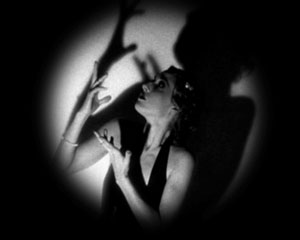印
象
中
国
(JB) Marina Foxley showed the first part of her “Impressions of China” programme yesterday, and I'd like to write some lines on my two favorites - “The Bridge” by Xu Xin (2007) and “Terrace” by Song Di (2006) . “The Bridge” is a non-narrative documentary on the border to the cinematic essay, comparable perhaps to the films NYC and Belgrade films we had seen on Monday, but with a decisive political undertone. The film's subject is the gigantic Nanjing Yangtze River Bridge, which is not only a important part of Nanjing's infrastructure, but also a kind of monument to the Chinese People's Republic's engineering potential. Xu Xin's film, though, ignores the heroic aspect of the bridge, focussing rather on small scenes of people somehow associated with the bridge or simply passing by, like a young tourist couple taking pictures, some workers whiling away time in their cabin or a man in a raincoat trying to cross bridge at a traffic light, which – judging from the display attached to the lights – is set to just 7 seconds, so crossing it within the allocated time frame and not getting stuck in the middle of the road seems like a veritable feat in itself. Obviously – besides taking pictures for your album –, the bridge is not intended for any kind of true interaction between architecture and the people; a problem often plaguing institutions and structures in political systems which have to put the identifier “People's” into their denomination, as the connection between “people” and “society” might be eventually overlooked otherwise. There is an irony to the social realist statue depicting the traditional warrior/worker/doctrinaire standing on the side of the bridge, shown at the beginning of the film – it should have rather been a miniature replica of the bridge itself, or maybe the Chinese mainland (think of Ai Weiwei's sarcastic “Map of China”, carved from the remnants of a destroyed historical temple), instead of any kind of even aesthetically & politically streamlined individual. Unsurprisingly, the Nanjing Yangtze River Bridge is a popular suicide venue in China; Xu Xiu states a number of 2000 people at the end of the film, a supposedly unauthorised but still shocking statistic.
“The Bridge” is a non-narrative documentary on the border to the cinematic essay, comparable perhaps to the films NYC and Belgrade films we had seen on Monday, but with a decisive political undertone. The film's subject is the gigantic Nanjing Yangtze River Bridge, which is not only a important part of Nanjing's infrastructure, but also a kind of monument to the Chinese People's Republic's engineering potential. Xu Xin's film, though, ignores the heroic aspect of the bridge, focussing rather on small scenes of people somehow associated with the bridge or simply passing by, like a young tourist couple taking pictures, some workers whiling away time in their cabin or a man in a raincoat trying to cross bridge at a traffic light, which – judging from the display attached to the lights – is set to just 7 seconds, so crossing it within the allocated time frame and not getting stuck in the middle of the road seems like a veritable feat in itself. Obviously – besides taking pictures for your album –, the bridge is not intended for any kind of true interaction between architecture and the people; a problem often plaguing institutions and structures in political systems which have to put the identifier “People's” into their denomination, as the connection between “people” and “society” might be eventually overlooked otherwise. There is an irony to the social realist statue depicting the traditional warrior/worker/doctrinaire standing on the side of the bridge, shown at the beginning of the film – it should have rather been a miniature replica of the bridge itself, or maybe the Chinese mainland (think of Ai Weiwei's sarcastic “Map of China”, carved from the remnants of a destroyed historical temple), instead of any kind of even aesthetically & politically streamlined individual. Unsurprisingly, the Nanjing Yangtze River Bridge is a popular suicide venue in China; Xu Xiu states a number of 2000 people at the end of the film, a supposedly unauthorised but still shocking statistic.
 “Suicide is the subject matter of Song Di's film, too; however, this one is entirely fictional and decidedly narrative. In 12 minutes, Song Di develops the heart-warming story of a school-girl giving a lesson in practical escapism to a suicidal elderly man on the brink of hurling himself from a tower block. Just as the film seems to get overpowered by its feel-good magical realism tone, the story takes a rather tragic turning; I won't spoil the ending, but let's say that this isn't exactly Mary Poppins. It isn't Suicide Circle or a Takashi Miike movie, either; the tragicomical setting rather reminded me of the fine traditions of Czech or Finnish cinema, or, to build a bridge to a different art form, to the romantically infused accounts of utter failure by artists like Urs Lüthi or Peter Land. There is no false melodrama in Song Di's short, but rather a kind of dandyesque defiance of the inevitable; the protagonist rigs himself up in swimming trunks and goggles for his attempt at the final jump.
“Suicide is the subject matter of Song Di's film, too; however, this one is entirely fictional and decidedly narrative. In 12 minutes, Song Di develops the heart-warming story of a school-girl giving a lesson in practical escapism to a suicidal elderly man on the brink of hurling himself from a tower block. Just as the film seems to get overpowered by its feel-good magical realism tone, the story takes a rather tragic turning; I won't spoil the ending, but let's say that this isn't exactly Mary Poppins. It isn't Suicide Circle or a Takashi Miike movie, either; the tragicomical setting rather reminded me of the fine traditions of Czech or Finnish cinema, or, to build a bridge to a different art form, to the romantically infused accounts of utter failure by artists like Urs Lüthi or Peter Land. There is no false melodrama in Song Di's short, but rather a kind of dandyesque defiance of the inevitable; the protagonist rigs himself up in swimming trunks and goggles for his attempt at the final jump.
Thursday's “Strange Stories” compilation had its share of unfortunate deaths, too; firstly, there was Erik Urlings' “Knäbelflocken” (2007), an utterly bizarre and rather indescribable short which seemed like a crossover between a gangster movie, a Dada performance and a free-mason initiation ritual, set in the ruins of a small countryside chapel; then, Lucas Figueroa's “Boletos por Favor” (“The Tickets, Please”) from 2007, with a Harold-Pinter-style take on the utter horror of fare dodging. Again, the plot takes a couple of twists, and I wouldn't like to spoil the fun for anyone; so try to catch it yourself if you haven't been able to attend Thursday's screening. On a side note – while the film was set entirely inside a moving train, and, more specifically, the already rather dubious space between two compartments, Figueroa had included some CGI special effect shots of the train passing through a kind of post-apocalyptic but retro-looking landscape, which I found remarkable because they were virtually superfluous for the plot itself, but still added an additional sense of style to the film.
 Finally, there was an underlying tragedy and the presumptive doom of one of the protagonists of André Werner's “The Eyes of Mankind” (2007). While there was a considerable amount of archival cinematic snippets involved in Werner's take on expressionist Sci-Fi drama (think Murnau here), it had far more original footage than the afore-mentioned “Flash”, and a clear-cut and highly condensed plot. The nostalgic effect of the aesthetics and narrative structure was subtly undermined by the plot, which was essentially about, well, the triumphant victory of the moving image over its printed predecessor. I'd love to see a similarly made full feature film by Werner, but I suppose it would take years of work simply browsing the archives for adequate material (and, let's face it, expressionist film-making's narratives might indeed have deserved some radical compression in their own time, too, so maybe 14 minutes is just about the right length, after all).
Finally, there was an underlying tragedy and the presumptive doom of one of the protagonists of André Werner's “The Eyes of Mankind” (2007). While there was a considerable amount of archival cinematic snippets involved in Werner's take on expressionist Sci-Fi drama (think Murnau here), it had far more original footage than the afore-mentioned “Flash”, and a clear-cut and highly condensed plot. The nostalgic effect of the aesthetics and narrative structure was subtly undermined by the plot, which was essentially about, well, the triumphant victory of the moving image over its printed predecessor. I'd love to see a similarly made full feature film by Werner, but I suppose it would take years of work simply browsing the archives for adequate material (and, let's face it, expressionist film-making's narratives might indeed have deserved some radical compression in their own time, too, so maybe 14 minutes is just about the right length, after all).
Bye for now - JB



 Spree Getraenke
Spree Getraenke











0 Comments:
Post a Comment